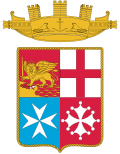This article needs additional citations for verification .(November 2016) |
 | |
| Class overview | |
|---|---|
| Name | Rossetti class |
| Builders | Cantiere Navale Picchiotti, Viareggio (Livorno) |
| Operators | |
| In commission | 1986–1989 |
| Planned | 2 |
| Completed | 2 |
| Active | 2 |
| General characteristics | |
| Type | Coastal research vessel |
| Displacement | 324/330 tonnes, full load |
| Length | 44.6 m (146 ft) |
| Beam | 7.9 m (26 ft) |
| Draught | 2.0 m (6.6 ft) |
| Propulsion |
|
| Speed | 12 knots (22 km/h; 14 mph) |
| Range | 1,700 nautical miles (3,100 km; 2,000 mi) |
| Crew |
|
| Sensors & processing systems | 2 x GEM Elettronica SPN-753 navigation radar, X band |
The Rossetti class of coastal research vessels consists of two units operated by the Italian Navy and named as "Nave Esperienze" (experiences ship). [1] The vessels are used by Centro Supporto Sperimentazioni Navali (Naval Experimentation Support Centre) for technologies research and development trials on anti-submarine weapons.
